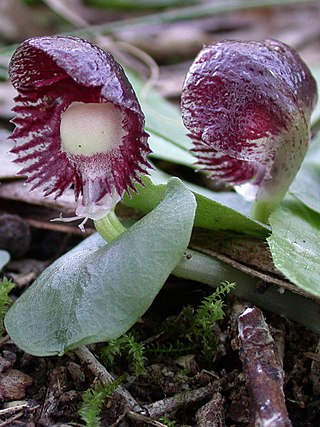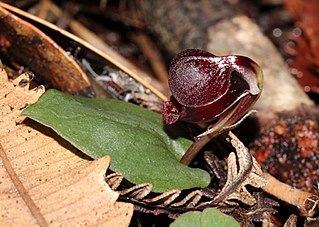
Cyanicula aperta, commonly known as the western tiny blue china orchid, is a plant in the orchid family Orchidaceae and is endemic to Western Australia. It has a relatively narrow leaf and a single bluish-mauve flower. It is distinguished from the other two similar blue orchids by the sides of the labellum which are erect but well-separated from the column. This species also has a more easterly distribution than C. amplexans and C. sericea.

Corybas hispidus, commonly known as the bristly helmet orchid, is a species of orchid endemic to eastern Australia. It is distinguished from other helmet orchids by its autumn to winter flowering period, and by its labellum, which has a bristly-hairy, creamy-white centre and is deeply notched along its top edge.
Pterostylis aspera, commonly known as the rough shell orchid, is a species of orchid endemic to the south-west of Western Australia. As with similar greenhoods, the flowering plants differ from those which are not flowering. The non-flowering plants have a rosette of leaves flat on the ground but the flowering plants have a single flower with leaves on the flowering spike. In this common species, the flower is white with green and reddish-brown stripes and a short, straight labellum.
Corybas globulus is a species of helmet orchid endemic to a small area of the New England Tableland in northern New South Wales. It is a relatively small orchid with a bright green, heart-shaped leaf and a bulbous, dark reddish purple flower.
Corybas abditus, commonly known as the swamp helmet orchid or small helmet orchid , is a species of terrestrial orchid endemic to Western Australia. It is a rare orchid with a single bluish green, heart-shaped leaf and a small flower with an enlarged dorsal sepal and tube-shaped labellum.
Corybas abellianus, commonly known as the nodding helmet orchid, is a species of terrestrial orchid endemic to tropical north Queensland. It forms small colonies and has single heart-shaped, dark green leaf with a silvery white lower side and a reddish purple flower with a curved dorsal sepal.

Corybas barbarae, commonly known as fairy lanterns, is a species of terrestrial orchid endemic to eastern Australia including Lord Howe Island. It has a single dark green or reddish green, heart-shaped leaf and a small sparkling white or pinkish flower with an inflated dorsal sepal obscuring its hairy labellum.
Corybas cerasinus, commonly known as the red helmet orchid, is a species of terrestrial orchid endemic to tropical north Queensland. It has a single bluish green, heart-shaped leaf and a cherry red to dark maroon flower with its curved dorsal sepal obscuring its labellum which has an upturned tip.

Corybas diemenicus, commonly known as the stately helmet orchid or veined helmet orchid, is a species of terrestrial orchid endemic to south-eastern Australia. It has round or heart-shaped leaf and a reddish purple flower with a central white patch.

Corybas dowlingii, commonly known as red lanterns, is a rare species of terrestrial orchid endemic to New South Wales. It grows in colonies and has a round or heart-shaped leaf and a dark purplish red flower with white patches in the labellum.
Corybas expansus, commonly known as the flared helmet orchid or dune helmet orchid is a species of terrestrial orchid that is endemic to South Australia. It has a heart-shaped to more or less round leaf and a single purplish flower with greenish or transparent areas.

Corybas fimbriatus, commonly known as the fringed helmet orchid, is a species of terrestrial orchid endemic to eastern Australia. It has a broad egg-shaped to round leaf and a dark reddish purple to crimson flower with translucent patches. It is similar to C. hispidus but its labellum lacks a creamy-white centre and is not covered with bristly hairs.
Corybas fordhamii, commonly known as the banded helmet orchid or swamp helmet orchid, is a species of terrestrial orchid endemic to south-eastern Australia. It has an egg-shaped to heart-shaped leaf and a reddish to reddish purple flower which leans forward. It is similar to C. unguiculatis which does not grow in swamps and has a different labellum.

Corybas incurvus, commonly known as the slaty helmet orchid, is a species of terrestrial orchid endemic to south-eastern Australia. It has a broad egg-shaped to heart-shaped leaf and a dark purple flower with a white patch in the middle.
Corybas limpidus, commonly known as the crystal helmet orchid, is a species of terrestrial orchid endemic to Western Australia. It has round or heart-shaped leaf and a translucent greenish flower with dark red or burgundy-coloured spots and blotches. The edges of the labellum have a few short, blunt teeth.
Corybas × miscellus, commonly known as the hybrid helmet orchid, is a hybrid species of terrestrial orchid endemic to South Australia and a very small area in far western Victoria. It has a heart-shaped to more or less round leaf and a single reddish purple flower with greyish translucent areas. It is a natural hybrid between C. diemenicus and C. incurvus and shares the characteristics of the parent species.
Corybas montanus, commonly known as the montane helmet orchid, is a species of terrestrial orchid endemic to Queensland. It forms small colonies and has single heart-shaped to round leaf and a reddish, self-pollinating flower with a curved dorsal sepal. It is only known from the Mount Barney National Park in south-east Queensland.

Corybas recurvus, commonly known as the western helmet orchid or common helmet is a species of terrestrial orchid endemic to Western Australia. It has round or heart-shaped leaf and a dark reddish purple or purplish black flower. It is widespread and common between Bunbury and Albany.

Corybas undulatus, commonly known as tailed helmet orchid, is a species of terrestrial orchid endemic to eastern Australia. It has a single leaf and a single translucent grey flower with reddish markings, and a labellum with a bristly surface, fine teeth on the edge and a small tail on the tip.

Corybas unguiculatus, commonly known as the small helmet orchid or pelicans, is a species of terrestrial orchid endemic to south-eastern Australia. It is a widespread, sometimes common but small orchid with a single leaf and a single reddish purple to reddish black flower.











